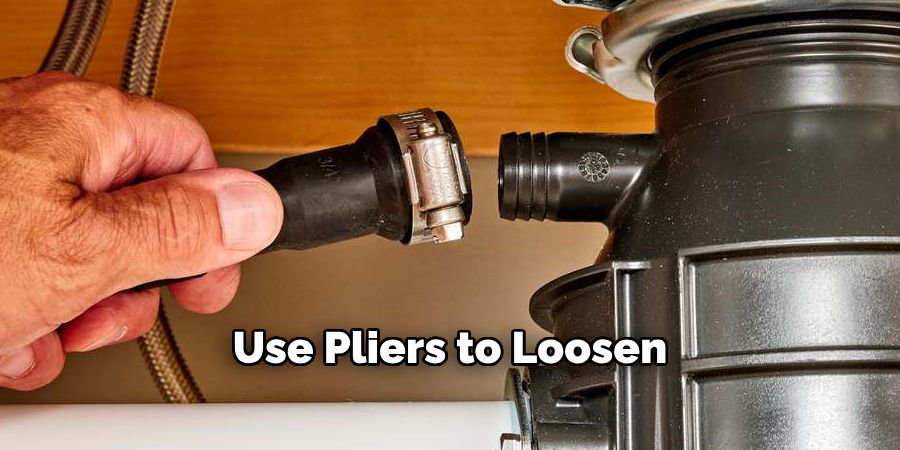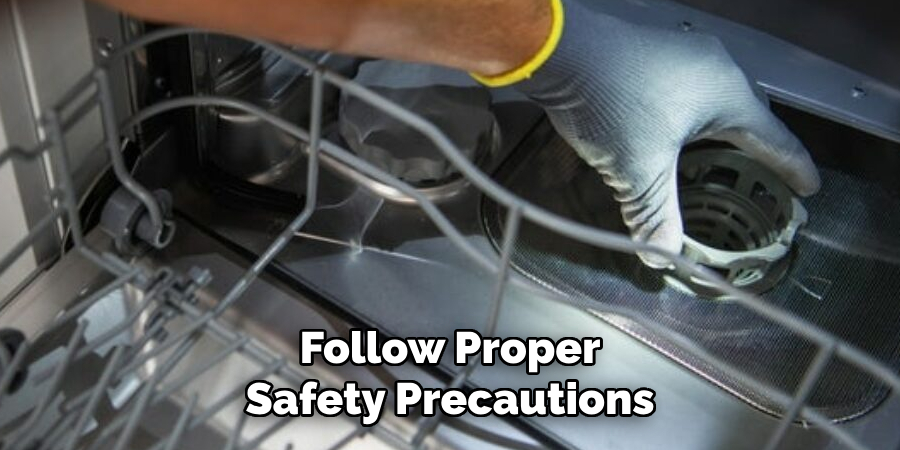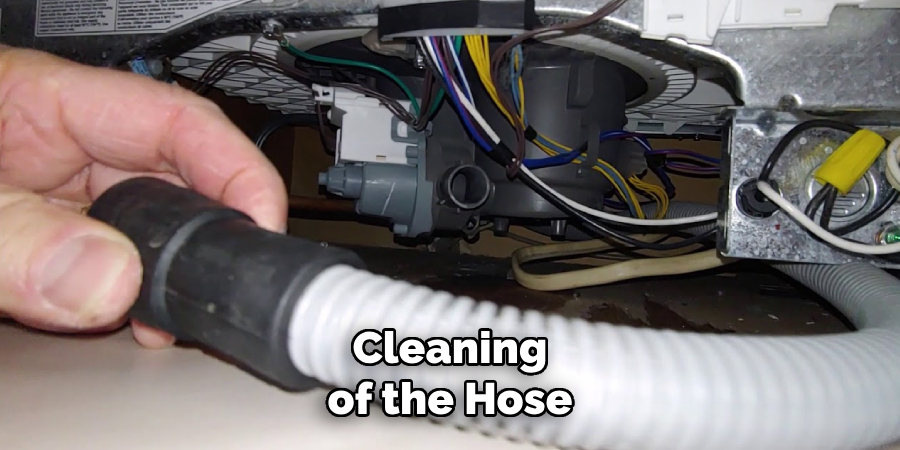Removing a dishwasher drain hose might seem like a daunting task, but with the right tools and a step-by-step approach, it can be done efficiently and safely.

Whether you’re replacing a damaged hose or upgrading your plumbing setup, understanding the proper procedure is essential to avoid leaks and ensure your dishwasher continues to function properly.
This guide on how to remove a dishwasher drain hose will walk you through the process, making it simple for both beginners and experienced DIY enthusiasts.
Why Remove a Dishwasher Drain Hose?
Before we delve into the actual steps, let’s understand why you might need to remove a dishwasher drain hose in the first place.
There are several reasons why you may need to do this, including:
- Replacing a damaged or clogged hose
- Upgrading to a longer or more durable hose
- Moving the dishwasher to a different location
No matter what your reason may be, it’s essential to take caution and follow proper procedures to avoid any damage or complications.
What You Will Need
Depending on your specific situation, you may need some or all of the following tools and materials:
Pliers
These will come in handy for loosening and removing any hose clamps or connections.
Screwdriver
You may need a screwdriver to remove the dishwasher panel or access cover to locate and reach the drain hose.
Bucket
To catch any water that may spill during the removal process, have a bucket ready nearby.
8 Step-by-step Guidelines on How to Remove a Dishwasher Drain Hose
Step 1: Disconnect the Dishwasher from Power
Before beginning the removal process, ensure your safety by disconnecting the dishwasher from its power source. Locate the dishwasher’s power cord and unplug it from the electrical outlet under the sink or behind the appliance.

If the dishwasher is hardwired to your home’s electrical system, you will need to turn off the circuit breaker. Double-check that the dishwasher is completely powered off before proceeding to prevent any risk of electrical shock.
Step 2: Turn off the Water Supply
If your dishwasher is connected to a water supply, you’ll need to turn it off before removing the drain hose. Locate the shut-off valve under the sink and turn it off by turning the handle clockwise.
This step is crucial to prevent any water from spilling out of the disconnected hose once removed.
Step 3: Remove the Access Panel or Cover
To access the dishwasher drain hose, you will need to remove the access panel or cover located at the bottom front of the dishwasher. Use a screwdriver to carefully unscrew the screws securing the panel in place. Once the screws are removed, gently pull the panel away from the dishwasher to reveal the internal components.
Be sure to keep track of the screws and set them aside in a safe place to make reassembly easier later. Removing the access panel will provide better visibility and access to the drain hose, allowing you to proceed with the next steps efficiently.
Step 4: Locate the Drain Hose
Look for the dishwasher drain hose, which is typically a flexible tube made of plastic or rubber. It connects to the dishwasher pump and drains out any wastewater into the sink’s plumbing system or disposal unit. The hose may be attached to the sink with a clamp or connected directly to the garbage disposal.
The location of the drain hose may vary slightly depending on the dishwasher model and installation setup. Refer to the manufacturer’s manual if you’re having trouble locating it.
Step 5: Disconnect the Hose from the Sink or Disposal
To remove the hose, you’ll need to disconnect it from either where it connects to the sink drain pipe or disposal unit.
If there is a clamp securing the hose in place, use pliers to loosen and remove it carefully. If there is no clamp, you may be able to twist or pull the hose off its connection point with some force.

Be cautious not to damage any of the connections or surrounding pipes during this step.
Step 6: Disconnect the Hose from the Dishwasher
Once you’ve disconnected the hose from the sink or disposal, you’ll need to remove it from the dishwasher. The hose is usually connected to a plastic or metal fitting on the side of the dishwasher with a clamp.
Use pliers to loosen and remove the clamp, then gently pull the hose off the connection point. Again, be careful not to damage any surrounding components during this step.
Step 7: Drain Any Remaining Water
Even after turning off the water supply, there may still be some residual water in the drain hose that needs to be emptied before complete removal.
To do this, place your bucket under one end of the hose and disconnect it from the other. The water will flow out into the bucket, so be prepared to catch it all.
Step 8: Remove the Hose
With everything disconnected and drained, you can now remove the entire dishwasher drain hose from your appliance. Inspect the hose for any signs of damage or clogs before disposing of it.
Following these steps on how to remove a dishwasher drain hose will help you safely and effectively remove a dishwasher drain hose without any complications. Remember to follow proper safety precautions and consult the manufacturer’s manual for specific instructions related to your dishwasher model.

Additional Tips
- If you’re unsure of how to remove the drain hose, refer to the manufacturer’s manual for your dishwasher model. It should have specific instructions and diagrams to guide you.
- Wear gloves and eye protection while handling any plumbing components to avoid injury.
- When installing a new hose, make sure it is compatible with your dishwasher model and follows proper installation guidelines for optimal functioning. So, always consult a professional if you are uncertain or uncomfortable performing this task yourself. There are also many online resources available that provide detailed tutorials and video guides on how to remove a dishwasher drain hose for various models.
- Be sure to properly dispose of the old hose according to your local waste management guidelines.
- Regular maintenance and cleaning of your dishwasher drain hose can help prevent clogs and avoid the need for frequent removal. Refer to our other guides on how to clean a dishwasher drain hose for more information.
- If you encounter any difficulties during the removal process, do not force or damage any components. Instead, seek professional assistance for safe and efficient removal.
Frequently Asked Questions
Q: Can I Reuse the Old Drain Hose?
A: It is generally recommended to replace the old drain hose with a new one, especially if it’s damaged or clogged. However, if it’s still in good condition and you’re confident in reusing it, make sure to thoroughly clean and inspect it before reinstalling.
Q: How Do I Choose the Right Replacement Hose?
A: When selecting a new dishwasher drain hose, consider the length, material (plastic or rubber), and connection points. Measure the distance between the dishwasher’s drain outlet and where it connects to either the sink or disposal unit to ensure you get the correct size. It’s also essential to match the type of connections on both ends of the hose for a proper fit.
Q: Can I Install a Longer Drain Hose?
A: Yes, you can install a longer drain hose as long as it doesn’t exceed 10 feet in length. However, it’s not recommended as a longer hose can affect the dishwasher’s performance and may cause draining issues.
Q: How Often Should I Replace the Dishwasher Drain Hose?
A: The dishwasher drain hose should be replaced every 5-8 years or if you notice any signs of damage, leaks, or clogs. Regular maintenance and inspection of the hose can extend its lifespan and prevent any potential issues with your dishwasher’s draining system.
Q: Why is it Important to Regularly Remove and Clean the Dishwasher Drain Hose?
A: Over time, debris, grease, and other particles can accumulate in the dishwasher drain hose, leading to clogs and blockages. Regular removal and cleaning of the hose can prevent these issues and help maintain your dishwasher’s efficiency. It also ensures proper drainage of wastewater from your dishwasher without any backups or leaks. So, making it a part of your regular dishwasher maintenance routine is essential for its proper functioning.

Conclusion
Removing a dishwasher drain hose may seem like a challenging task, but with proper precautions and careful execution, it can be done without any major complications.
Be sure to follow these step-by-step guidelines on how to remove a dishwasher drain hose to ensure a safe and successful removal process. Remember to also consult your appliance’s manual or seek professional help if you encounter any difficulties. With the right tools and techniques, you can easily remove and replace a dishwasher drain hose to keep your appliance functioning efficiently.
Happy plumbing!
Professional Focus
Angela Ervin, a former interior designer turned blogger, specializes in kitchen design and renovations. Through her website, she blends her passion for cooking with design expertise, sharing practical and creative ideas. Known for balancing functionality and beauty, Angela’s insightful content has made her a trusted voice in home design and lifestyle.
About the Author
Angela Ervin, an experienced interior designer and blogger, combines her passion for kitchen renovations with storytelling. Living in Petersburg with her family, she enjoys cooking and testing her projects firsthand. Known for her humor and relatable style, Angela shares creative, functional design insights through her content, making her a trusted voice in home design.
Education History
University: Virginia Commonwealth University
Degree: Bachelor of Fine Arts (BFA) in Interior Design
- Angela’s education at VCU focused on mastering core interior design principles, including spatial planning, color theory, materials selection, and sustainable design practices.
- She gained hands-on experience through studio projects and collaborative design exercises, which honed her ability to create functional and aesthetically pleasing environments.
- Her coursework also emphasized problem-solving and practical applications of design, preparing her for real-world projects like her self-directed kitchen renovations.
- The program’s strong foundation in both technical skills and creative expression shaped Angela’s ability to seamlessly integrate form and function in her work.
